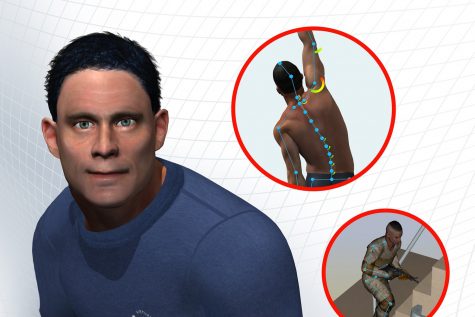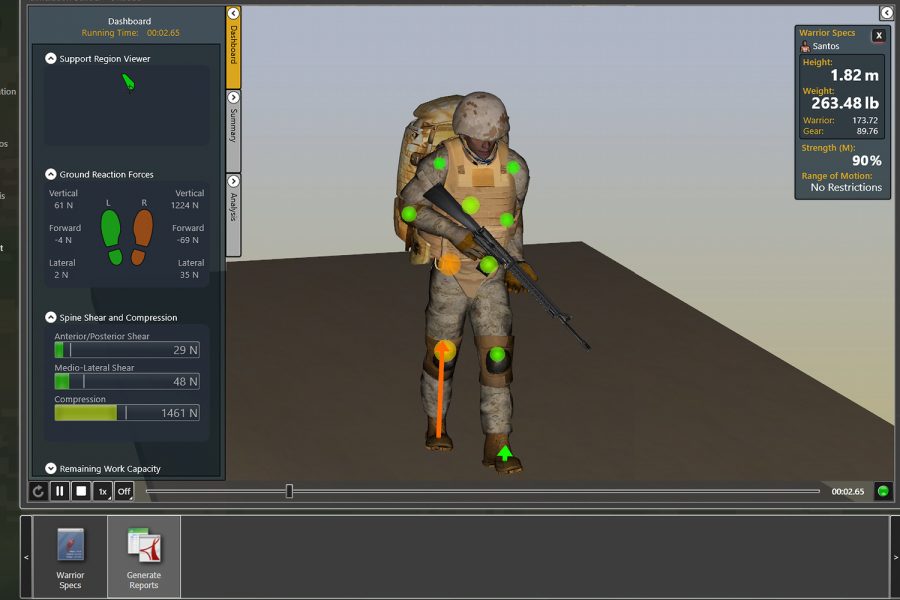UI virtual-avatar program allows for equipment, activity testing for U.S. soldiers
The UI Technology Institute is collaborating with the U.S. military to virtually test equipment and the effect of physical activity on the human body.
“Santos is a customizable, physics-based, biomechanically accurate virtual human that can measure how humans would respond while completing various tasks in different environments.”(Contributed/University of Iowa Institute of Technology)
July 28, 2020
Researchers at the University of Iowa Technology Institute aim to make a real-world impact with virtual reality, working closely with the U.S. military and various corporations to test products using virtual avatars in realistic simulations.
The institute is collaborating with the U.S. Army to test the effects of protective equipment and training exercises on soldiers using Santos, a virtual avatar from its Virtual Soldier Research Program.
Iowa Technology Institute Director Karim Abdel-Malek and his team created the program in 2005 in an effort to analyze soldier performance without testing real people, which he said cuts spending by about 30 percent and reduces potential injury.
“Before Santos, when somebody designs a new helmet or a new grenade that will attach to the soldier, or a new weapons system, the easiest way was to bring in all the varieties in person, and it takes years to analyze the data,” he said. “We now are doing a lot of work to reduce the time and cost without having so many people involved.”
Santos also has a female counterpart, Sophia. Researchers can virtually “drag and drop” protective equipment or other materials onto the virtual avatar to analyze if male and female soldiers can carry out tasks, Abdel-Malek said.

Analyzing the effects of equipment and tasks on the human body required collaboration outside of the institute, he added, including engineers, physical therapists, medical professionals, and ophthalmologists.
RELATED: Second phase announced for reopening UI research facilities
“Physical therapists understand what fatigue does to the muscles, and the ophthalmologists at the university provided us with appropriate measures of acuity and flickering of the eyes,” Abdel-Malek said. “Representing real humans into the model, we want to be able to understand what your body can and cannot do and feed it into the program.”
He said Santos comprises not only human components, but also artificial intelligence, kinematics, bio-mechanics, and gaming technology.
“Artificial intelligence is a thriving field,” Abdel-Malek said. “It is all of the thinking behind [Santos]. Santos will see someone shooting at him, and you want him to think on his own. He can think, ‘I’ll take a new position,’ or he’ll shoot back. All of the positions must be fed into the program so it can think as a brain.”
Unlike other virtual avatars that are based solely on gaming technology, Santos is physics-based. While both simulate a realistic environment, Abdel-Malek said Santos expresses human limitations.
“Games are prescribed,” he said. “The robotic person in the game has only three or four elements. Santos is a human being and can tell you whether or not he is able to do things. You can try things on him, and he will explore it and tell you if he is comfortable.”
UI Technology Institute Executive Director of Programs Travis Klopfenstein said Santos is special because he can turn an avatar into a digital twin of the soldier.
RELATED: UI researchers develop technology to promote sustainable farming
“It’s similar in the way it went from maps to GPS,” Klopfenstein said. “The way the military is currently testing walking, marching, and movements of soldiers is old school. We have the potential to create a simulation environment where individuals are digital twins of who you are on your team. Give them a task, such as walking 10 miles. [Santos] will calculate the water they are intaking, fatigue, and spinal compression. It calculates the human cost.”
Klopfenstein, a veteran of the U.S. Air Force, said flight simulations changed pilot training, and the U.S. Army uses simulations for testing vehicles, but did not have a method for virtual testing soldier performance. He said virtual soldier simulations are the key to making military and other businesses’ training safer for the individual.
“I look back on all my experience — all my training in the field,” he said, “There is some training you cannot test [in person] as it is limited by expenses. Now, the army is looking for ways to test training for the soldier, and they are going to need a human model. [Santos] is a revolutionary innovation.”
UI Technology Institute Application Developer Marco Tena Salais said learning how to work with cutting-edge technology in a real-life setting is a unique experience.
One of his most difficult projects was integrating the Santos code into a pre-existing military program so the simulation would calculate energy expenditures, Tena Salais said. He had total freedom to test himself to see if he could measure up to the institute’s expectations and his own, he said.
“There are not many places you can say you learned how to 3D model, render engines, and learn how to put on body armor for simulations,” he said. “[The institute] is a research facility that is making a real-world impact.”



















